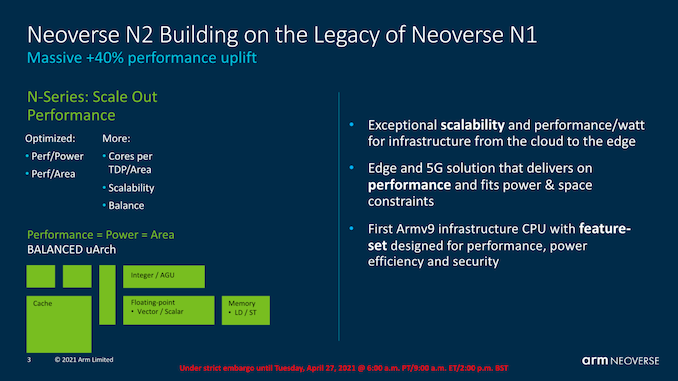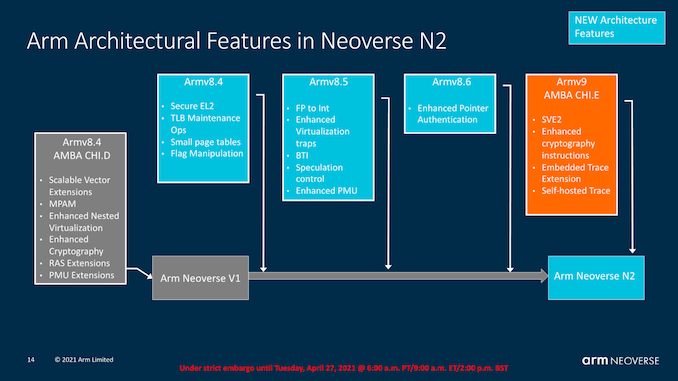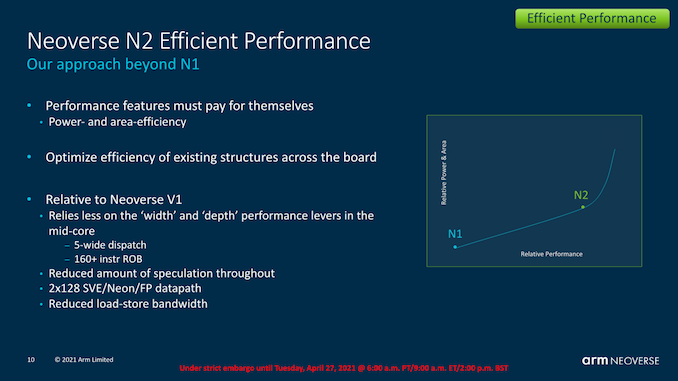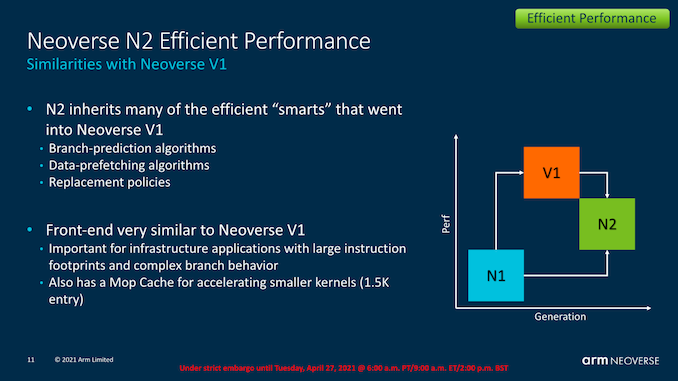Arm Announces Neoverse V1, N2 Platforms & CPUs, CMN-700 Mesh: More Performance, More Cores, More Flexibility
by Andrei Frumusanu on April 27, 2021 9:00 AM EST- Posted in
- CPUs
- Arm
- Servers
- Infrastructure
- Neoverse N1
- Neoverse V1
- Neoverse N2
- CMN-700
The Neoverse N2 µArch: First Armv9 For Enterprise
Moving from the performance oriented Neoverse V1 to the more balanced Neoverse N2 core, we’re seeing a different approach to performance, more akin to the Cortex-A78’s PPA focus versus the X1’s performance focus.
Arm makes note of the “balance” keyword here – the microarchitecture only adopts features and design changes if those changes actually contribute to an increase of the PPA (Performance, Power, Area) equation of the IP. In contrast, the V1 would opt for performance increasing features even if that meant a disproportionate increase in power and area, reducing the total PPA of the design.
Architecturally, the N2 is a newer core than the V1 and takes a higher architectural baseline as the foundation of its capabilities. It’s Arm’s first disclosed Armv9 capable core, including important new features such as SVE2. It’s to be noted that although Arm talked a lot about Armv9 CCA (Confidential Compute Architecture) last month, the Neoverse N2 core does not feature this capability, which is an extension we’re told to expect in future microarchitecture designs.
Arm’s microarchitectural disclosures on the N2 were rather limited compared to the details we’ve seen on the V1. This being a sibling core to the yet undisclosed next generation Cortex-A78 successor, we’ll have to wait a few more months to see exactly what differentiates this newer iteration compared to the Cortex-A78, besides the notable Armv9 features and new SVE2 pipelines.
Arm at least confirms that it’s a narrower microarchitecture in the sense that there’s only a 5-wide dispatch (compared to 8-wide in the V1), and the design features 2x128b native SVE2 and NEON pipelines.
The company states that the new design should still achieve an impressive +40% increase in IPC compared to the Neoverse N1, which is actually substantial given the fact that we’re promised only a linear increase in power and area.
In terms of “smarts”, or better said, microarchitectural innovations, the N2 is a super-set of the V1, just with a more conservative approach to block and structure sizes.
System side features, on top of MPMM and DT, PDP, or Performance Defined Power Management is a feature newer to the N2 that promises to vary the CPU’s microarchitectural features depending on workloads, in order to reduce power consumption without impacting performance. I imagine here that we’re talking about smarter workload dependent clock-gating of microarchitectural features, for example narrowing of the execution resources in low-IPC workloads.

















95 Comments
View All Comments
Dug - Tuesday, April 27, 2021 - link
Now is when I wish ARM was publicly traded.mode_13h - Tuesday, April 27, 2021 - link
Well, you could buy NVDA, under the assumption the acquisition will go through.dotjaz - Thursday, April 29, 2021 - link
SoftBank is already publicly traded on the Tokyo Stock Exchange. Why rely on NVIDIA buyout which for all likelihood won't happen any time soon if at all.mode_13h - Thursday, April 29, 2021 - link
> SoftBank is already publicly traded on the Tokyo Stock Exchange.They also invested heavily in WeWork, when it was highly over-valued. I have no idea what other nutty positions they might've taken, but I think it's not a great proxy for ARM just due to its sheer size.
cjcoats - Tuesday, April 27, 2021 - link
As an environmental modeling (HPCC) developer: what is the chance of putting a V1 machine on my desk in the foreseeable future?Silver5urfer - Tuesday, April 27, 2021 - link
Never. Since there has to be an OEM for these chips to put in DIY and Consumer machines, so far except the HPE's A64FX ARM there's no way any consumer can buy these ARM processors and that is also highly expensive over 5 digit figure. And then the drivers / sw ecosystem comes into play, there's passion projects like Pi as we all know but they are nowhere near the Desktop class performance.ARM Graviton 2 was made because AWS wants to save money on their Infrastructure, that's why their Annapurna design team is working there. Simply because of that reason Amazon put more effort onto it AND the fact that ARM is custom helps them to tailor it to their workloads and spread their cost.
Altra is niche, Marvell is nowhere near as their plans was to make custom chips on order. And from the coverage above we see India, Korea, EU use custom design licensing for their HPC Supercomputer designs.
Then there's a rumor that MS is also making their own chips, again custom tailored for their Azure, Google also rumored esp their Whitechapel mobile processor (it won't beat any processor on the market that's my guess) and maybe their GCP oriented own design.
These numbers projection do look good vs x86 SMT machines finally to me after all these years, BUT have to see how they will compete once they are out vs 2021 HW is the big question, since if these CPUs outperform the EPYC Milan technically AWS should replace all of them right ? since you have Perf / Power improvements by a massive scale. Idk, gotta see. Then the upcoming AMD Genoa and Sapphire Rapids competition will also show how the landscape will be.
SarahKerrigan - Tuesday, April 27, 2021 - link
If they don't replace all the x86 systems in AWS with ARM, that *must* mean Neoverse is somehow secretly inferior, right??Or, you know, it could mean that x86 compatibility matters for a fair chunk of the EC2 installed base, especially on the Windows Server side (which is not small) but on Linux too (Oracle DB, for instance, which does not yet run on ARM.)
Silver5urfer - Tuesday, April 27, 2021 - link
That was a joke.Spunjji - Friday, April 30, 2021 - link
Was it, though? Schrodinger's Joke strikes again.Raqia - Tuesday, April 27, 2021 - link
Maybe not an V1 but you could probably get a more open high performance ARM core than the Apple MX series pretty soon:https://investor.qualcomm.com/news-events/press-re...
"The first Qualcomm® Snapdragon™ platforms to feature Qualcomm Technologies' new internally designed CPUs are expected to sample in the second half of 2022 and will be designed for high performance ultraportable laptops."